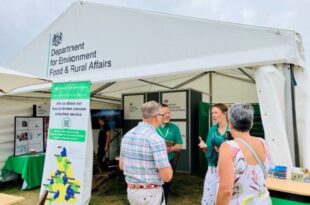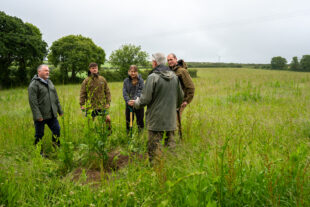
In April, I blogged about the outcome of the first round of Slurry Infrastructure grants. In that post, I said we were planning to launch 2 further, larger rounds in Autumn 2023 and 2024.
I’m pleased to say that we are getting ready to open the second round of Slurry Infrastructure grants in November. To help farmers get ready, we published the full guidance for the grant on GOV.UK.
We hosted a webinar about the scheme on Thursday 23 November 2023. You can watch the webinar online if you missed it.
In this post, I’ll explain what’s new about the second round and how you can prepare. I’ll also answer a question we often get asked about covering slurry stores by 2027.
The grant
Grants of between £25,000 and £250,000 are available to improve your slurry storage to go beyond legal minimums.
This will help you improve the use of organic nutrients on your farm, aiding productivity and reducing pollution.
The grant is only available for slurry stores located in England.
What’s new
Since launching the first round, we’ve gathered valuable suggestions how we can improve the Slurry Infrastructure grants.
Based on feedback gathered online, at shows and on farms, we are making 5 changes to the scheme for the second round:
- We are changing how much storage you can apply for. As in the first round, cattle farmers will still be offered funding to achieve 6 months slurry storage. But now pig farms will be funded for up to 8 months storage. This will help pig producers with less land to safely store organic nutrients until they can safely spread it or export it to neighbouring farms to meet crop and soil needs.
- You can get a grant towards a slurry separator as part of your project to increase storage capacity. Separators can make slurry easier to store, move around the farm and apply in line with a nutrient management plan. The grant will provide a contribution towards a screw or screen press separator unit, gantry, and temporary storage of stackable materials. As this is the first time we’re supporting separators on a large scale, Defra and the Environment Agency published updated guidance on GOV.UK to clarify how slurry rules apply and best practice.
- We will support covering for existing stores that are fit-for-purpose with impermeable covers. This will help farms who have recently invested in storage to further increase capacity by preventing rainwater from entering the store. You can use this option alongside building a store, or on its own, so long as you meet the scheme storage requirements and minimum grant thresholds.
- We are adding the option to build in-situ cast concrete stores as an alternative to circular and panel stores, lagoons and bags. This will improve flexibility in certain areas where it is harder to transport in pre-cast panels.
- We are introducing an option for landlords to underwrite grant funding agreements, giving tenants more confidence to apply, where their landlord agrees to take over their agreement if they don’t complete the project.
We are making these changes to improve flexibility and environmental outcomes.
We appreciate some farms in round 1 may want to amend their application to take advantage of the revised offer.
RPA will contact first round applicants with a time-limited opportunity to update their application if they want to include these changes in their project, without having to reapply.
We aren’t planning to make further changes to the items on offer for the third round.
Managing demand
In the second round, we will be able to invite many more projects to submit a full application than we did last year. However, depending on how many farms apply, we may still need to limit the number of full applications to prevent swamping suppliers.
If we need to, we will prioritise projects in areas where coordinated action is needed to reduce water and air pollution from farming. This will ensure available public money is targeted to areas where it can make the biggest improvement to environmental outcomes.
We have significantly expanded these areas for the second round by adding further indicators for water quality and using the latest air quality data.
You can view the areas by selecting Slurry Infrastructure Grant – Round 2 (England) on MAGIC. In the updated guidance published today, we explain what the priority areas show and how we’ll use them.
The likelihood of your project being shortlisted in round 2 will depend on how many farms apply. Last year, around 30% of projects shortlisted were outside the prioritised areas.
We therefore strongly encourage everyone who wants a grant to submit an expression of interest when online applications open, wherever you are located.
What happens next
You will be able to apply in November. Subscribe to the blog to receive a reminder when the online checker, the first step to apply, opens.
Once the online checker closes, we’ll know the level of demand.
Shortly after that, we’ll tell everyone whether they will be invited to submit a full application this round or not
If you aren’t shortlisted, there will be another opportunity to apply in 2024, where we will look to further widen the target areas.
You can get ready to apply by working out how much slurry storage you need to reach the scheme storage requirements.
You must use AHDB’s latest version of slurry wizard — October 2023 or later — to do this. It’s been significantly updated based on last year’s farmer experience.
Covering slurry stores
One of the questions we get asked the most is whether all slurry stores will need to be covered by 2027. This was a suggestion made in the Clean Air Strategy, published in 2019.
Covering slurry stores is a well-established practice to minimise ammonia emissions. It’s set out in the Code of Good Agricultural Practice (COGAP). Earlier this year, the government restated its committed to consult on rules to reduce ammonia emissions from management of organic manures, including requirements to cover slurry and digestate stores.
You should be confident that any stores built through the Slurry Infrastructure grant will be compliant with future rules. The scheme has been designed to invest in high specification stores and covers that maximise ammonia abatement.
All stores will not need to be covered unless or until new rules are brought in. Farmers will be given plenty of notice and support to implement any new changes. We do not expect that any new rules will require existing stores to be covered with impermeable covers by 2027.




Leave a comment